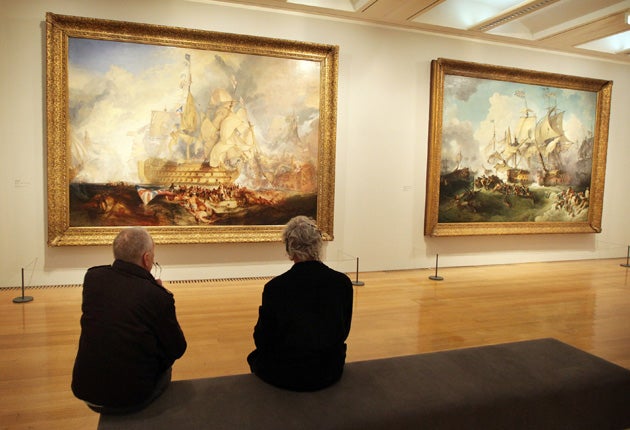Eat your art out: Turner's nasty side revealed
Britain's great seascape specialist was also a master of oneupmanship

Your support helps us to tell the story
From reproductive rights to climate change to Big Tech, The Independent is on the ground when the story is developing. Whether it's investigating the financials of Elon Musk's pro-Trump PAC or producing our latest documentary, 'The A Word', which shines a light on the American women fighting for reproductive rights, we know how important it is to parse out the facts from the messaging.
At such a critical moment in US history, we need reporters on the ground. Your donation allows us to keep sending journalists to speak to both sides of the story.
The Independent is trusted by Americans across the entire political spectrum. And unlike many other quality news outlets, we choose not to lock Americans out of our reporting and analysis with paywalls. We believe quality journalism should be available to everyone, paid for by those who can afford it.
Your support makes all the difference.He is celebrated as one of the world's foremost landscape artists and a revered member of the British canon.
But what is less known about JMW Turner is his over-weaning competitive tendencies and desperate desire for "one-upmanship", not just over his contemporaries but also old master painters.
Whether it was Turner's working-class chip – he was born in a humble household above a barber's shop in Covent Garden – or his ambitious need to upstage masters ranging from Claude Lorrain to Constable, a new exhibition reveals him to have had a fiercely competitive streak that led to a series of flagrant attempts to take centre stage.
Turner and the Masters, an exhibition that opens at Tate Britain tomorrow, reveals that when Turner was asked by his patron and collector, the Duke of Bridgewater, to paint an accompanying work of art to hang alongside the scene created by the Dutch painter, Willem van de Velde, entitled Ships in a Stormy Sea, the English painter decided to produce Dutch Boats in a Gale, a painting that was far larger than the Dutch artist's original, forcing Bridgewater to give it gallery space on a single wall, rather than hang it next to its counterpart.
Ian Warrell, co-curator of the show, said the incident was a fine example of Turner's competitive tendencies.
"There was an element of competition in which he wanted to blast someone out of the water. The physical size of this 'companion' painting was bigger. These companion pieces were normally meant to be mirror images of the original, but Turner takes the elements of Van de Velde's original and ups the ante. They had to be shown at opposite ends of the room and they have not been seen together since the early 19th century, until now," said Mr Warrell.
Another incident illustrates his ongoing competition with his contemporary John Constable, who, in 1831, was part of the hanging committee at the Royal Academy of Arts. Constable decided that a work by Turner should be removed from one of the best wall spaces in the gallery, and hung his own painting there.
The following year, Constable's painting The Opening of Waterloo Bridge was hung next to Turner's seascape, Helvoetsluys, as part of the annual Summer Exhibition of 1832. When Turner saw Constable's work, which was eye-catching in its use of red and which the artist had spent years working on, he tried to trump it, altering his own painting so that it contained a stark red buoy in the middle of a largely colourless sea scene.
Constable saw the change and remarked bitterly: "He has been in here and fired a gun." The paintings have not been shown together since 1832.
Professor David Solkin, the exhibition's curator, said the move was a salvo in an ongoing battle between the two artists. "The procedure at the Royal Academy was that a few days before an exhibition opened to the public, the artists were allowed to come and touch up their work.
"As Constable was adding more and more rich colours to his canvas, Turner came in with his palette, went up to his very much simpler picture and put a daub of bright red, about the size of a shilling, into the water in his picture and left the gallery.
"The point was to say 'less is more' – his simple addition of a bit of red made Constable's very highly worked piece look overcooked and the repository of too much effort," he said.
Join our commenting forum
Join thought-provoking conversations, follow other Independent readers and see their replies
Comments